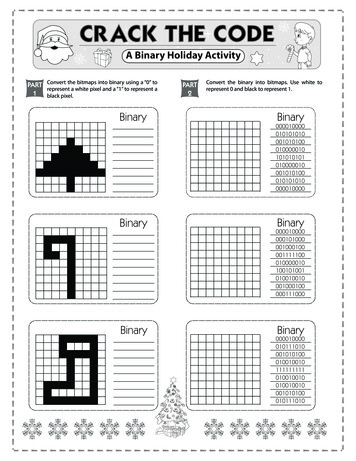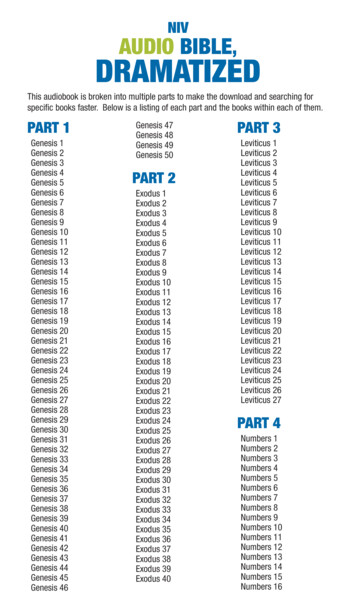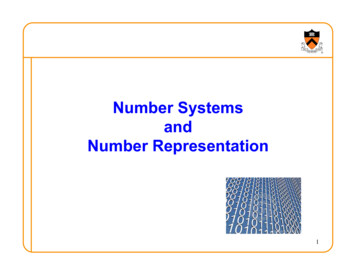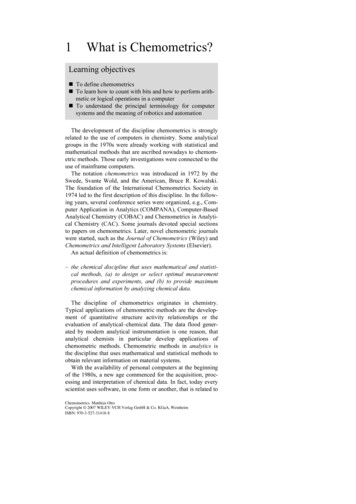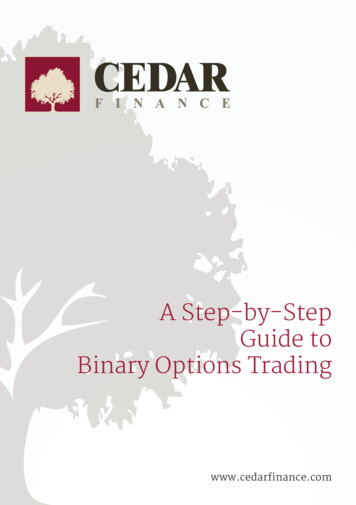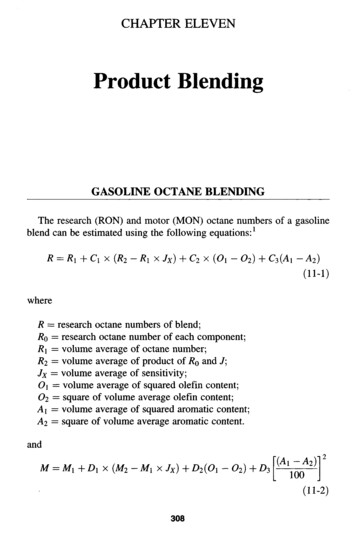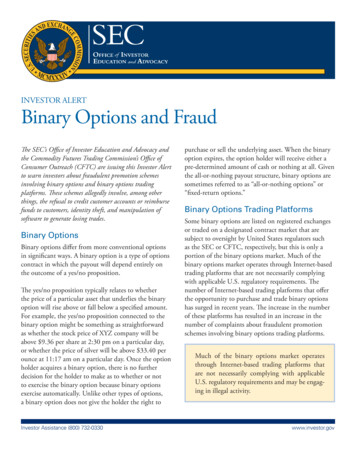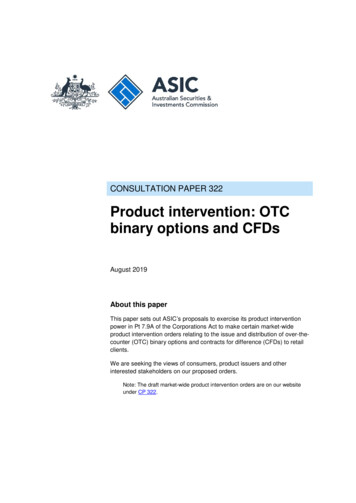
Transcription
Part 2:Introduction to BinaryNumbers & Arithmetic2/04/20191
Decimal vs. binary representationThe decimal number 805means8x102 0x101 5x100.The place values, fromright to left, are1,10,100,1000,., or100,101,102,103,. .The base or radix is 10.All digits must be less thanthe base, i.e. from 0 to 9.2/04/2019The binary number 10112means1x23 0x22 1x21 1x20.The place values, fromright to left, are 1,2,4,8,.,or 20,21,22,23,. .The base or radix is 2 (indecimal) or 102 (in binary).All digits must be less thanthe base, i.e. either 0 or 1.2
Advantages of binary representationBinary notation isconvenient for electronicprocessing because:(1) Only two voltage levelsare needed to represent alldigits;(2) Arithmetic tables aresimple, and can beimplemented using logicgates.2/04/2019Addition table:0 0 00 0 1 011 0 01 1 1 10Multiplication table:0x0 0 0x1 01x0 0 1x1 1Each table has 4 entries.In decimal, each tablewould have 10010 entries!(Notice that 4 1002 .)3
Converting from base xWhile computers work in base 2, people prefer base 10.So conversions to and from binary are needed. We canillustrate the methods using a 4-digit integer in anarbitrary base. The number abcdx (base x) meansax3 bx2 cx d.This polynomial can be used directly to convert thenumber to decimal. We can reduce the number ofarithmetical operations in the conversion by writing thepolynomial in nested form:((ax b) x c) x d.2/04/20194
Converting from base x - ExamplesTaking the example from slide 2,10112 1. 23 0. 22 1. 21 1. 20 8 0 2 1 11or, in nested form,10112 ((1. 2 0) . 2 1) . 2 1 11.Here’s an example in base 7:410357 (((4 . 7 1) . 7 0) . 7 3) . 7 5 9973.In base 16 (known as hexadecimal or “hex”), we use theletters A to F to represent the “digits” 10 to 15 :FFFFhex ((15 . 16 15) . 16 15) . 16 15 65535.2/04/20195
Converting to base xThe nested form((ax b) x c) x dcan be writtenabcdx Cx dwhere C Bx cwhere B ax bwhere a 0x a.Now all the above arewhole numbers, and2/04/2019a,b,c,d are all less than x,being the digits of a base-xnumber. So the equationsat left imply that d,c,b,a arethe remainders when abcdxis divided repeatedly by x.To convert a whole numberto base x, divide itrepeatedly by x until thequotient is zero, and writethe remainders in reverse.6
Converting to base x - ExamplesTo convert 1110 to binary,we repeatedly divide by 2.Let us write the quotientson the left and remainderson the right:115 12 11 00 12/04/2019Reading the remainders upthe column gives 10112.To convert 9973 to base 7:99731424520332904104The result is 410357.7
Converting fractions from base xThe number abcd. pqrsx (base x) meansax3 bx2 cx d px-1 qx-2 rx-3 sx-4 .The part to the left of the radix point (.) is the integer partand the part to the right is the fractional part. Again, theabove expression may be used to convert the number todecimal. (Exercise: Can you devise a nested form tospeed up the calculation?)To convert from decimal to base x, the integer part isprocessed by the repeated-division method, while thefractional part requires separate treatment [next slide].2/04/20198
Converting fractions to base xThe fractional part (red) ofabcd.pqrsx ispx-1 qx-2 rx-3 sx-4 .Multiply by x :p qx-1 rx-2 sx-3 .Take the fractional part andmultiply by x again:q rx-1 sx-2 .Repeat the separate-andmultiply step until there is2/04/2019no fractional part left*:r sx-1s 0.Now read off the resultinginteger parts (red) inforward order, and you getthe base-x digits pqrs.* If the process doesn’tterminate itself, stop whenyou’ve got enough digits.9
Example: Convert 11.8125 to base 8For the integer part, werepeatedly divide by 8(remainders are in blue):111 30 1Integer part is 13 8 .For the fractional part, werepeatedly multiply by 8[next column].2/04/2019Each line in the table is 8times the fractional part ofthe previous line:.81256.54.0Fractional part is .64 8 .Answer:11.8125 10 13.64 8 .10
Example: Convert 6.410 to base 7The integer part is trivial:606Integer part is 6 7 .The fractional part is 4/10.Since 10 is not divisible by7, repeated multiplicationby 7 will never cancel thedenominator and neverconvert the fractional part2/04/2019to an integer. So theprocess will not terminate:.42.85.64.21.4.and this pattern repeats.Answer: 6.25412541.11
Notes on base conversionsIn explaining how to convert to base x [slides 6 & 9], wehave written the given numbers in powers of x to showwhy the methods work. In the worked examples, ofcourse, we have written the given numbers in decimal.Because we humans prefer base 10, we use repeateddivision to convert to other bases, and power-seriesexpressions to convert to base 10.But a computer prefers base 2. So it works the other wayaround, using repeated division to express its results inbase 10, and power-series expressions to convert humaninput to base 2.2/04/201912
Octal (base 8)It is especially easy to convert between octal and binary:abcdefgh2 a.27 b.26 c.25 d.24 e.23 f.22 g.2 h (a.2 b).26 (c.22 d.2 e).23 (f.22 g.2 h) (ab2).82 (cde2).8 (fgh2)The expressions in parentheses, being less than 8, are theoctal digits. The process can also be reversed. Note thatone octal digit corresponds to three binary digits because8 23. The binary digits (“bits”) are grouped from rightto left, i.e. away from the radix point.2/04/201913
Binary-octal conversion - Examples(1) Convert 10111110101100011010001000 2 to octal :010 111 110 101 100 011 010 001 000 * 2 7 6 5 4 3 2 1 08 276543210 8 .(* The leading 0 is optional. Each conversion of threebinary digits to one octal digit is done by inspection.)(2) Fractional parts are grouped from left to right andpadded with zeros (the proof is left as an exercise).Example: Convert 11111111.10001 2 to octal:011 111 111 . 100 010 2 377.42 8 .2/04/201914
Hexadecimal or “hex” (base 16)We have seen that one octal digit corresponds to 3 bitsbecause 8 23. Similarly, one hex digit corresponds to 4bits because 16 24. The following generalized exampleincludes a fractional part, which must be padded with a 0:abcdef.ghijklm 2 a.25 b.24 c.23 d.22 e.2 f g.2-1 h.2-2 i.2-3 j.2-4 k.2-5 l.2-6 m.2-7 (a.2 b).24 (c.23 d.22 e.2 f ) (g.23 h.22 i.2 j).2-4 (k.23 l.22 m.21 0).2-8 (ab2).16 (cdef2) (ghij2).16-1 (klm02).16-2.2/04/201915
Hex-binary conversion - Examples(1) Convert 789ABCDEFhex to binary:0111 1000 1001 1010 1011 1100 1101 1110 1111 2 .(The leading 0 can be omitted. Conversion of individualhex digits can be done by inspection; recall that the lettersA to F represent the “digits” 10 to 15.)(2) Convert 1011100.101101 2 to hex:0101 1100 . 1011 0100 2 5C.B4 hex .(The digits are counted off away from the radix point.The trailing zeros on the fractional part are needed tocomplete the group of four. The leading 0 is optional.)2/04/201916
Conversion to binary via octalThe direct conversion of200110 to binary looks likethis .2001100050025012562311573102/04/201910001011111. and gives 11111010001.It may be quicker toconvert to octal first .200125031301273. yielding 3721 8 , whichcan be instantly convertedto 11 111 010 001 2 .17
Negative numbers & subtractionMathematicians definesubtraction as addition ofthe additive inverse:a - b a (-b).In theory, this trick reducessubtraction to addition. Inpractice, we still needsubtraction because we usea magnitude-sign notationfor negative numbers.2/04/2019That is, if b is positive, wewrite its additive inverse as-b - b and we evaluate a (-b) asa - b.To eliminate subtraction inbase-10 integer arithmetic,we can represent -b by thenines complement or tenscomplement of b.18
Nines-complementsIf we confine the discussion to 4-digit decimal arithmetic,the nines complement of b is defined asb’ 104 - 1 - b 9999 - b.Evaluation of the nines complement does not require thefull subtraction algorithm, because there is no borrowing.Each digit is simply subtracted from 9.In nines-complement arithmetic, we represent -b by b’.The numbers 0 to 4999 are represented literally, while -0to -4999 are represented by 9999 down to 5000. Zero canbe represented as 0000 or 9999.2/04/201919
Subtraction by nines-complementsSuppose a and b are in the range 0 to 4999. Thena b’ a 9999 - b 9999 a - b 9999 - (b-a).If a b, then a b’ 9999, which means 0, which is a-b.If a b, then a b’ is at least 104, and we must subtract9999 to obtain a-b ; this can be done by adding the carryfrom the leftmost column (“end-around carry”). If a b,we see from the green expression that a b’ (b-a)’,which represents a-b (and has no end-carry). Also,a’ b’ 9999 - a 9999 - b 9999 (a b)’.The end-around carry leaves (a b)’, which means -a-b.2/04/201920
Nines-complement examples(1) 2708 - 1984:2708 8015 ( 1984’ ) 107231 (end-around carry) 0724.(2) 1984 - 2708:1984 7291 ( 2708’ ) 9275 ( 0724’ ).End-around carry is zero.Result means -724.2/04/2019(3) -2708 - 1984:7291 ( 2708’ ) 8015 ( 1984’ ) 153061 (end-around carry) 5307 ( 4692’ ).Result means -4692.(4) 2708 1984:This is trivial, as no conversions arerequired. The result is 4692.21
Tens-complementsWe can eliminate the double representation of zero and theend-around-carry by using the tens complement, which isfound by adding 1 to the nines complement. Hence, in 4digit decimal arithmetic, the tens complement of b isdefined asb* 104 - b.In tens-complement arithmetic, 0 to 4999 are representedliterally, while -1 to -5000 are represented by 9999 downto 5000, which are the tens complements of 1 to 5000.Zero is always 0000. Note that 5000 is not represented.2/04/201922
Subtraction by tens-complementsAgain, suppose a,b are in the range 0 to 4999. Thena b* a 104 - b 104 a - b 104 - (b-a).If a b or a b, then a b* is at least 104 and reduces toa-b if we throw away the carry. If a b, we see from thegreen expression that a b* (b-a)*, which is less than104 (leaving no carry) and represents a-b. Also,a* b* 104 - a 104 - b 104 (a b)*.Discarding the carry leaves (a b)*, which means -a-b.In all cases, discarding the carry (if any) gives the tenscomplement representation of the expected result.2/04/201923
Tens-complement examples(1) 2708 - 1984:2708 8016 ( 1984*) 10724or 0724 (discarding carry).(2) 1984 - 2708:1984 7292 ( 2708*) 9276 ( 0724*).No carry to discard.Result means -724.2/04/2019(3) -2708 - 1984:7292 ( 2708*) 8016 ( 1984*) 15308or 5308 (discarding carry).Result is 4692*and means - 4692.(4) 2708 1984:This is trivial. The result is 4692.[Slide 21 does the sameexamples in nines-comp.]24
Overflow in tens-complementSuppose a,b are in the range 0 to 4999. Thena b* 104 a - b 104 - (b - a).The result is in the range 5001 to 14999. After the carry(if any) is dropped, this represents -4999 to 4999, whichis the correct range for a-b.But if a b 4999, then a b represents a negativenumber; this is positive overflow.Recall that a* b* becomes (a b)* when the carry isdropped. If a b 5000, then (a b)* 5000 and standsfor a positive number, not -a-b; this is negative overflow.2/04/201925
Negative numbers in binaryThe nines complement in decimal corresponds tothe ones complement in binary. In both notations,the carry from the most significant digit is added tothe least significant digit (“end-around carry”).The tens complement in decimal corresponds tothe twos complement in binary. In both notations,the carry from the most significant digit isdropped.[The next 10 slides concern ones- and twos complements.]2/04/201926
Ones-complementsIn n-digit binary arithmetic, the ones complement of b isb’ 2n - 1 - b.In binary, 2n - 1 is a row of n ones. So to find b’, wesubtract each digit from 1, or invert each digit; this iscalled a bitwise inversion.In ones-complement arithmetic, we represent -b by b’.The numbers 0 to 2n-1 - 1 are represented literally [for n 4,these numbers are 0000 to 0111], while -0 to -(2n-1 - 1) arerepresented by 2n - 1 down to 2n-1 [1111 down to 1000].Zero can be represented as 0 or 2n - 1 [0000 or 1111].2/04/201927
Subtraction by ones-complementsSuppose a,b are in the range 0 to 2n-1 - 1. Thena b’ a 2n - 1 - b 2n - 1 a - b 2n - 1 - (b-a).If a b, then a b’ 2n - 1, which means 0, which is a-b.If a b, then a b’ is at least 2n , and we must subtract2n - 1 to obtain a-b ; this subtraction can be accomplishedby the end-around carry. If a b, then a b’ (b-a)’,which represents a-b (and has no end-carry). Also,a’ b’ 2n - 1 - a 2n - 1 - b 2n - 1 (a b)’.The end-around carry leaves (a b)’, which means -a-b.So a-b and -a-b evaluate correctly in ones-complement.2/04/201928
4-bit ones-complement examples(1) 0101 - 0010 (5 - 2):0101 1101 ( 0010’ ) 100101 (end-around carry) 0011 ( 3).(2) 0010 - 0101 (2 - 5):0010 1010 ( 0101’ ) 1100 ( 0011’ ).End-around carry is zero.Result means -3.2/04/2019(3) -0101 - 0010 (-5 - 2):1010 ( 0101’ ) 1101 ( 0010’ ) 101111 (end-around carry) 1000 ( 0111’ ).Result means -7.(4) 0101 0010 (5 2):This is trivial, as no conversions arerequired. The result is 0111 ( 7).29
Twos-complementsIn n-digit binary arithmetic, the twos complement of b isb* b’ 1 2n - b .In twos-complement arithmetic, the values 0 to 2n-1 - 1[0000 to 0111 for n 4] are represented literally, while thevalues -1 to -2n-1 [-0001 to -1000] are represented by 2n - 1down to 2n-1 [1111 down to 1000], which are the twoscomplements of 1 to 2n-1. Note that 2n-1 [1000] representsthe value -2n-1 [-1000] while the value 2n-1 [ 1000] is notrepresented. N.B.: Negative numbers are marked by a 1in the leftmost bit or Most Significant Bit (MSB). So theMSB is also the sign bit.2/04/201930
Subtraction by twos-complementsAgain, suppose a,b are in the range 0 to 2n-1 - 1. Thena b* a 2n - b 2n a - b 2n - (b-a).If a b or a b, then a b* is at least 2n and reduces toa-b if we throw away the end-carry (subtracting 2n ). Ifa b, then a b* (b-a)*, which represents a-b (and thereis no end-carry to throw away). Also,a* b* 2n - a 2n - b 2n (a b)*.Dropping the carry leaves (a b)*, which means -a-b.In all cases, discarding the carry (if any) gives the twoscomplement representation of the expected result.2/04/201931
4-bit twos-complement examples(1) 0101 - 0010 (5 - 2):0101 1110 ( 0010*) 10011or 0011 (discarding carry).(2) 0010 - 0101 (2 - 5):0010 1011 ( 0101*) 1101 ( 0011*).No carry to discard.Result means -3.2/04/2019(3) -0101 - 0010 (-5 - 2):1011 ( 0101*) 1110 ( 0010*) 11001or 1001 (discarding carry ).Result is 0111*and means -7.(4) 0101 0010 (5 2):This is trivial, as no conversions arerequired. The result is 0111 ( 7).[Slide 29 does the sameexamples in ones-comp.]32
Overflow in twos-complementSuppose a,b are in the range 0 to 2n-1 - 1. Thena b* 2n a - b 2n - (b - a).The result is in the range 2n-1 1 to 2n 2n-1 - 1. After anycarry is dropped, this represents -(2n-1 - 1) to 2n-1 - 1,which is the correct range for a-b.But if a b 2n-1 - 1, then a b represents a negativenumber; this is positive overflow.Recall that a* b* becomes (a b)* when the carry isdropped. If a b 2n-1, then (a b)* 2n-1 and representsa positive number, not -a-b; this is negative overflow.2/04/201933
Positive overflow detectionAddition of 4-bit positivenumbers without overflowlooks like this:0xxx 0xxx 0xxx .The carry in to the MSBmust have been 0, and thecarry out is 0. (We canrepeat the illustration forany number of bits.)2/04/2019Positive overflow lookslike this:0xxx 0xxx 1xxx .The carry in to the MSBmust have been 0, but thecarry out is 1.Overflow occurs whencarry in carry out.34
Negative overflow detectionAddition of negative twoscomplement numberswithout overflow:1xxx 1xxx 11xxx .The carry in to the MSBmust have been 1(otherwise the sum bitwould be 0), and the carryout is 1.2/04/2019Negative overflow:1xxx 1xxx 10xxx .The carry in to the MSBmust have been 0, but thecarry out is 1.So negative overflow, likepositive, occurs whencarry in carry out.35
Hardware overflow signalWe have seen that the condition for twos-complement*overflow iscarry in carry outin the MSB. An “XOR” gate has an output of 1 when theinputs are unequal. So if we define the overflow flag asoverflow (carry in) xor (carry out),it will be 1 (or “set” or “true”) when an overflow occurs.* The same condition works for ones-complement. To prove this, we have toconsider which of the cases on the preceding two slides can involve 1111, whichis not negative and breaks the rule that a 1 in the MSB signals a negative number.The proof is left as an exercise.2/04/201936
Half adderWhen two binary numbersare added [cf. slides 29 and32], the right-hand bits areadded using this additiontable [cf. slide 3]:0 0 00 0 1 011 0 01 1 1 10In the two-bit sum, theright bit is the sum bit andthe left bit the carry bit.2/04/2019Let the bits to be added beA and B, the sum bit S andthe carry bit C. Then theaddition table may beexpressed as a truth table:ABSC000001101010110137
Half adder (continued)The truth table is fullydescribed by the BooleanrelationsS A xor BC ABwhich lead directly to thegate implementation:ABSC2/04/2019In hand calculations, thesum bit is written under thecolumn, while the carry bitis added to the next columnto the left; that column hasthree bits to be added. Anadder accepting three 1-bitinputs is called a full adder[next slide]; one acceptingonly two inputs is called ahalf adder [left].38
Full adder - used in 4-bit adderA full adder adds threenumbers each of which cantake the values 0 and 1.The result lies in the range002 to 112 and can berepresented by a sum bitand carry bit, as in a halfadder.Suppose we want to addtwo 4-bit numbersA3A2A1A0 and B3B2B1B0 .2/04/2019Let the sum be S3S2S1S0 ,and let C1 be the carry intothe column of A1 and B1,etc. Let FA denote a fulladder and HA a half adder.The circuit is:A3 B3A2 B2A1 B1A0 B0FAFAFAHAC3S3C2S2C1S1S039
Full adder - implementation (1)Let Ci be the carry-in, S thesum, and Co the carry-out.TRUTH TABLEA B C i S Co0 0 00 00 0 11 00 1 01 00 1 10 11 0 01 01 0 10 11 1 00 11 1 11 1S is 1 if the inputs A,B,Ciinclude an odd number of1’s. Co is 1 if any two (ormore) inputs are 1’s.ABCiS2/04/2019Co40
Full adder - implementation (2)In the previous slide, theXOR and AND gates at thetop left comprise a halfadder, and the lower XORgate is part of a half adder.So the circuit may beredrawn as shown here.The labels ‘C’ and ‘S’distinguish between theoutputs of each HA. Thecarry-out variables fromthe two HAs are calledCAand CB ; CB is unused.ABCiHAC SCAHAC SCBS2/04/2019Co41
Full adder - implementation (3)Now let’s see if we can useCB in the calculation of Co .TRUTH TABLEA B Ci CA CB0 0 00 00 0 10 00 1 00 00 1 10 11 0 00 01 0 10 11 1 01 01 1 11 02/04/2019Co00010111From the truth table we seethat Co CA or CB . So theFA circuit simplifies to:A B CiHACAC SHAC SCBCoS42
Full adder - used in 4-bit subtractorTo subtract B3B2B1B0 fromA3A2A1A0 using twoscomplement arithmetic, weadd A3A2A1A0 to the twoscomplement of B3B2B1B0 .To find the complement,we invert the bits and addone. The “add one” stepcan be done by replacingthe right-hand half adderwith a full adder.2/04/2019Subtractor (with 0OF (overflow)43
4-bit adder/subtractorAn XOR gate is acontrolled inverter. If oneinput is 0, the output is theother input; if one input is1, the output is the inverseof the other input. We canuse XOR gates to selectbetween B3B2B1B0 and itsones complement. TheSel(ect) input also controlsthe "add one’’ 0FASelFAC4C3S3C2S2C1S1S0OF (overflow)44
The “ripple-carry” effect.In the 4-bit adders shown on the last few slides, the carryout from each FA is connected to the carry-in of the next.This system is called ripple-carry.Logic gates do not react instantaneously to changes intheir inputs. There is a delay in the calculation of C1.When C1 reaches its correct value, there is a further delayin the calculation of C2 (which depends on C1), and so on.So the carry “ripples” through the full adders. The sumbits also depend on the incoming carry bits, causing acumulative delay in the calculation of the sum.2/04/201945
Carry acceleration (1)Methods for reducing carry delay include the carry-selectadder (CSA) and carry look-ahead (CLA). These areuseful when we connect several 4-bit adders in cascade tomake a larger adder.In a 4-bit CSA, we have two complete 4-bit adders, onewith a carry-in of 0 and the other with a carry-in of 1. The“real” carry-in is used to select between the outputs of thetwo adders. The two sums and two carry-outs can becomputed while waiting for the carry-in from the previousadder in the chain.2/04/201946
Carry acceleration (2)In an adder with carry look-ahead (CLA), each FA has twocarry outputs, called generate carry (G) and propagatecarry (P). G means “Co 1” (regardless of Ci), while Pmeans “Co Ci”. Using G and P as intermediate values,all the carry-ins to a 4-bit adder can be computed from theinputs and C0 (C0 is the least significant or rightmost Ci).We can also produce G and P outputs for the whole 4-bitadder; P means “C4 C0”. When several 4-bit adders arecascaded, the G and P outputs of each adder can becombined like those of a single FA; the combining circuitis called a carry look-ahead generator (CLAG).2/04/201947
Arithmetic Logic Units (ALUs)The 4-bit adder/subtractor[slide 44] is the simplestexample of a multifunctionarithmetic unit; the “Sel”input selects the desiredfunction from the availableoptions.A more realistic multifunction unit would havemore functions, controlledby several “select” bits.2/04/2019One select bit mightdetermine whether thefunction is arithmetical(add, divide-by-2) orlogical (bitwise XOR,shift-right).A multifunction circuitwith arithmetical andlogical functions is calledan arithmetic logic unit(ALU).48
Binary-octal conversion - Examples (1) Convert 10111110101100011010001000 2 to octal : 010 111 110 101 100 011 010 001 000 * 2 7 6 5 4 3 2 1 0 8 276543210 8. (* The leading 0 is optional. Each conversion of three binary digits to one octal digit is done by inspection.)
